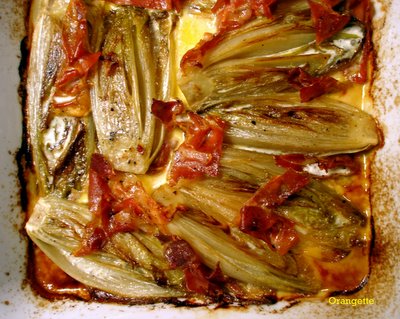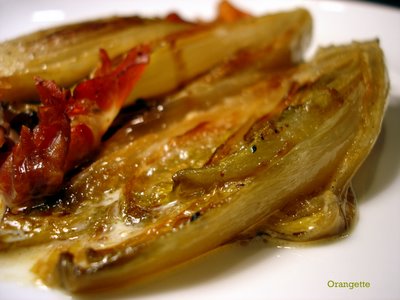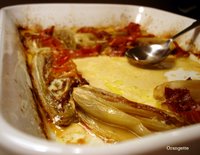How to endive
Formal education is useful, I guess, and so is a good upbringing, but all I really need to know I learned in France. Let others write odes to kindergarten; I owe it all—or a lot of it, at least—to Paris, plain and simple. It was there that I had my first taste of love, sweet, delicious, and doomed. It was there that I learned how to live with a family of strangers and, later, how to live alone. It was there that I learned how to love a city, its cement, its splendors, and its subway. And it was in France, dear reader, that I learned to swallow the bitter pill best known as endive—not a life lesson, perhaps, in the strict sense of the term, but a promising turn for a palate.
As a child, I was more picky than pleasant at the dinner table. Though there were few foods that I would wholly refuse, endive was one of them, along with bananas, mushrooms, and asparagus. My father, on the other hand, loved the stuff, and as fate would have it, he also loved grocery shopping. At least one out of every three trips to the store—which worked out to be quite a lot, in our house—would bring an attack of the small white torpedoes, cold and foreboding, sheathed in hard, squeaky leaves. He’d slip them into salads, where they’d lie in wait, caustic, amidst soft, ruffly lettuce leaves. Ever the inventor, he’d fashion from them bitter, bone-white spoons for scooping up salads of shrimp, peppers, and pesto. I learned from an early age to stealthily avoid endive, but it seemed to follow me—first over land, and then overseas.
So it was that at a modest table in southwestern Paris, I was cornered, conquered, and, at the tender age of twenty-one, taught to love endive. Maybe it was a simple matter of maturation, of taste buds and passing time, but there, confronted with an empty plate, a full bowl of salad, and the eyes of an entire host family, I was forced to reconsider. I scooped a spoonful of endive and apple onto my plate, the thin slices pleasantly indistinguishable under a nubbly coat of coarse-grain mustard vinaigrette. It was cold, crunchy, sweet, tart, and tangy, a small wintery welcome. It wasn’t love, but it was likable enough for a second helping. Repetition, it seems, works as well at the dinner table as it does in the classroom, because by the time a caramelized endive and goat cheese tart landed on my plate sometime the following spring, I was set to automatic swoon. Soft and burnished, the endive was mild and sweet, and propped against a cushion of pillowy cheese, it went down without a hitch.
I learned my lesson well, because it still does. I throw endive into salads alongside apples, pears, and pungent blue cheese. I sneak it into a bastardized Balthazar salad, where it folds itself happily alongside fennel, frisée, and radicchio. And it should come as no surprise that I often give it a good braise, my default treatment for misunderstood vegetables and other misanthropes.

With a good, steamy bath, endive melts into a soft, silky tangle. Its bitterness settles into a subtle complexity, an earthy sophistication smoothed by the velvet hand of heavy cream and a salty slap of prosciutto.

Braised into submission, it shares the plate quite nicely with roasted chicken or pork loin, but I’ll take my endive on its own, as a light but rich winter supper, with bread for sopping up the creamy pan juices and a simple green salad to start. There is no bitter pill that can’t be made better by braising—which is, if you ask me, all I really need to know anyway.
Braised Endive with Prosciutto
Adapted from All About Braising, by Molly Stevens
The original version of this recipe calls for browning the endive in butter, which helps to tame its bitterness, but with a feeble nod to my arteries, I have instead substituted olive oil for two-thirds of the butter. Happily, the end result does not seem to have suffered, and so far, neither have my arteries. For best results, choose endive with sleek, tight leaves and no bruises or discolorations, and opt for smaller specimens over large ones.
1 ½ pounds Belgian endive
2 Tbs olive oil
1 Tbs unsalted butter
3 thin slices prosciutto (about 2 ounces), cut crosswise into 1-inch-wide strips
½ cup good-quality chicken broth or stock
¼ cup heavy cream
Coarse salt, such as Maldon salt
Freshly ground black pepper
Preheat the oven to 375 degrees Fahrenheit.
Rinse the endive, dry them lightly, and remove their outermost leaves. If the root end is brown or looks dried out, trim it lightly. Cut each endive in half lengthwise.
Warm the olive oil in a large nonstick skillet over medium heat. Add as many endive as will fit in a loose layer, cut side down, and cook until the cut sides are nicely browned, about 4 minutes. Flip the endive, and cook them for a minute or two on the other side; them remove them to a large (9” by 13”) baking dish, arranging them cut side up. Add the butter to the skillet. When it has melted and is no longer foaming, add the remaining endive, and brown them as instructed above and place them in the baking dish. The endive should fit in a single layer in the dish.
There should still be a thin sheen of butter in the skillet. Still over medium heat, add the prosciutto to the skillet, and turn them gently but quickly to slick them with butter. Tuck the strips between, around, and on top of the endive in the baking dish.
Pour the chicken broth into the skillet, and bring it to a boil over medium-high heat. Using a wooden spoon or spatula, scrape the skillet to loosen any flavorful bits; then pour the hot broth over the endive and prosciutto in the baking dish.
 Cover the dish snugly with foil, slide it into the oven, and braise the endive until they are very tender when pierced with a paring knife, about 35 minutes. Remove the foil, and baste the endive by spooning over any juices in the pan. If the pan is dry, add 2 Tbs of water. Braise, uncovered, for another 8 to 10 minutes, until the pan juices have turned a caramel color and have almost completely evaporated. Pour over the heavy cream, and bake until it takes on a caramel color, about 6 minutes more. Serve warm or at room temperature, with salt and pepper to taste.
Cover the dish snugly with foil, slide it into the oven, and braise the endive until they are very tender when pierced with a paring knife, about 35 minutes. Remove the foil, and baste the endive by spooning over any juices in the pan. If the pan is dry, add 2 Tbs of water. Braise, uncovered, for another 8 to 10 minutes, until the pan juices have turned a caramel color and have almost completely evaporated. Pour over the heavy cream, and bake until it takes on a caramel color, about 6 minutes more. Serve warm or at room temperature, with salt and pepper to taste.
Yield: 3 to 6 servings, depending on what else is on the plate.

